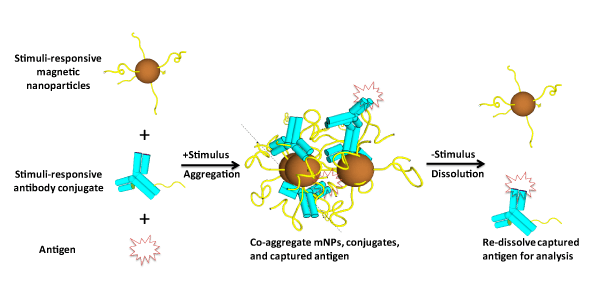Image: Stimuli-responsive binary reagent system, comprising stimuli-responsive magnetic nanoparticles (mNPs) and polymer?Ab conjugates. After application of an appropriate stimulus, the mNPs and conjugates coaggregate with captured antigen to form magnetically separable species. Reversing the stimulus provides the captured antigen free of magnetic particles.
Abstract
Magnetic microbeads exhibit rapid separation characteristics and are widely employed for biomolecule and cell isolations in research laboratories, clinical diagnostics assays, and cell therapy manufacturing. However, micrometer particle diameters compromise biomarker recognition, which leads to long incubation times and significant reagent demands. Here, a stimuli-responsive binary reagent system is presented that combines the nanoscale benefits of efficient biomarker recognition and the microscale benefits of rapid magnetic separation. This system comprises magnetic nanoparticles and polymer–antibody (Ab) conjugates that transition from hydrophilic nanoscale reagents to microscale aggregates in response to temperature stimuli. The binary reagent system was benchmarked against Ab-labeled Dynabeads in terms of biomarker isolation kinetics, assay speed, and reagent needs. Surface plasmon resonance (SPR) measurements showed that polymer conjugation did not significantly alter the Ab’s binding affinity or kinetics. ELISA analysis showed that the unconjugated Ab, polymer–Ab conjugates, and Ab-labeled Dynabeads exhibited similar equilibrium dissociation constants (Kd), ?2 nM. However, the binary reagent system isolated HIV p24 antigen from spiked serum specimens (150 pg/mL) much more quickly than Dynabeads, which resulted in shorter binding times by tens of minutes, or about 30–50% shorter overall assay times. The binary reagent system showed improved performance because the Ab molecules were not conjugated to large, solid microparticle surfaces. This stimuli-responsive binary reagent system illustrates the potential advantages of nanoscale reagents in molecule and cell isolations for both research and clinical applications.


